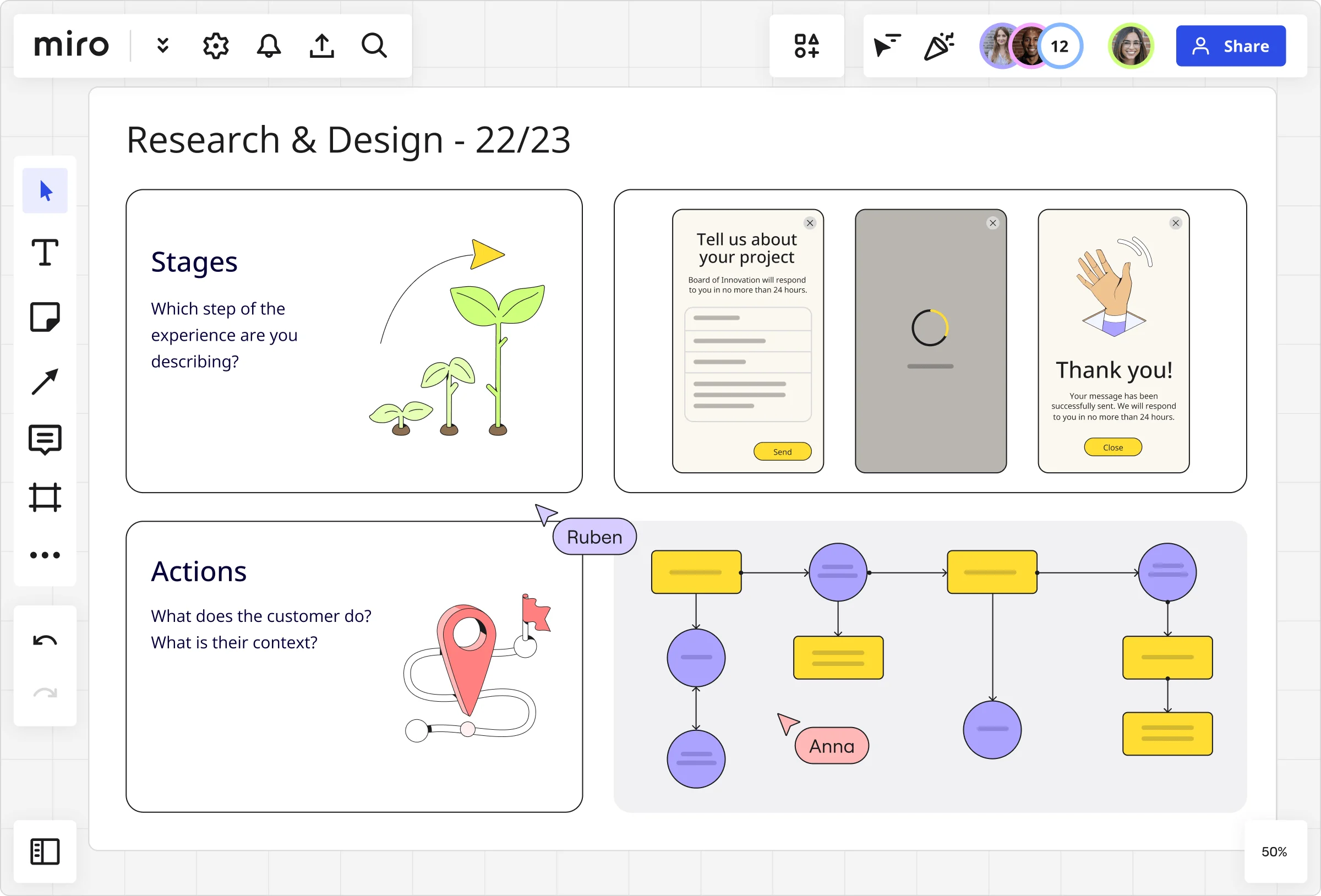
Table of contents
Table of contents
Product design process

What is the product design process? Everything you need to know
If you've ever wondered how your favorite app or software tool came to life, you're already thinking about product design. But what exactly does the product design process look like? Whether you're a UX designer, developer, or part of a product team, understanding this process is crucial for creating experiences that solve real user problems.
In this guide, we'll break down the product design process step by step, explain why it matters, and give you tips to avoid common mistakes. By the end, you'll have a clear roadmap for running a successful product design process from discovery to launch. Let's dive in.
Product design process explained
Product design is a structured process that takes an idea and turns it into a product that solves real problems for real people. It's about creating something functional and usable, not just visually appealing. The goal is to ensure the product addresses user needs effectively while aligning with business objectives.
The product design process generally follows these key steps:
Discovering the problem
Defining the problem
Defining the solution
Ideation and brainstorming
Prototyping and testing
Iteration and refinement
Finalization and launch
Each of these steps is critical to the success of your product. Let's walk through each one in detail.
Discovering the problem space
The first step in product design is discovering the problem space. This stage is about understanding what issues your product will solve and identifying the needs of your target users. The goal is to gather insights that will guide the rest of the process. This is where user research and market analysis come into play.
At this stage, it's crucial to conduct thorough research to understand the pain points and challenges your potential users face. Don't rely on assumptions; seek direct feedback through interviews, surveys, and observational studies. By doing so, you create a foundation based on real user insights.
Key aspects
Frameworks: Common frameworks for this stage include empathy maps, user personas, and customer journey mapping. These tools help you visualize and understand the user experience. Use methods like user interviews, surveys, and competitor analysis to gather data.
Teams involved: Product managers, UX researchers, and business analysts play key roles in discovering the problem space.
Key stakeholders: Besides the core teams, stakeholders from marketing, sales, and customer support can offer valuable insights.
Focus points: This stage focuses on gathering as much information as possible. Pay attention to recurring themes and unexpected findings, as they can guide the rest of the process.
How to run this process: Conduct qualitative research with user interviews to uncover pain points. Analyze market trends to ensure you're solving a problem with market demand.
Defining the problem
Once you've gathered your research, it's time to distill what you've learned into a single problem statement. This step is about clarity. A well-defined problem gives your team a clear direction and ensures that every design decision aligns with solving the user's core issue.
Frameworks: Try the Job-to-be-Done framework to articulate the tasks users are trying to accomplish and where they struggle.
Teams involved: Product managers and UX designers collaborate closely here, ensuring alignment between the user's needs and business objectives.
How to run this process: Create a problem statement that's specific, measurable, and actionable. Make sure all team members agree on the definition before moving forward.
Defining the solution
Once you clearly understand the problem space, the next step is to define the solution. This stage involves narrowing your focus and creating a vision for your product. The goal is to identify the core features and functionalities that will address the problems you've discovered.
Defining the solution requires a balance between user needs and business objectives. You'll need to establish design principles that guide your product development. The key is creating a concise vision that aligns all teams and stakeholders.
Key aspects
Frameworks: Common frameworks for this stage include user stories, feature prioritization, and Minimum Viable Product (MVP) planning. These tools help you determine the essential features of your product.
Teams involved: Product managers, UX designers, and technical leads are central to defining the solution.
Key stakeholders: Beyond the core teams, stakeholders from marketing and business development should be consulted to ensure alignment with broader company goals.
Focus points: Focus on simplicity and avoid over-engineering. Prioritize features that directly address the user needs identified earlier in the process.
Ideation and brainstorming
Ideation is the stage where creativity takes center stage. This is where you generate a wide range of ideas and concepts for your product. The goal is to explore all possibilities and push the boundaries of innovation. Effective ideation requires a collaborative approach that encourages open-mindedness and inclusivity.
During ideation, fostering a safe space where team members feel comfortable sharing their ideas is crucial. Techniques like design thinking workshops and collaborative whiteboarding can help generate diverse concepts. This stage thrives on creativity, so be open to unconventional ideas.
Key aspects
Frameworks: Common frameworks for ideation include design thinking, mind mapping, and brainstorming sessions. These techniques help teams think creatively and explore various angles.
Teams involved: Ideation involves a mix of UX designers, product managers, and engineers. This cross-functional collaboration is essential for generating a wide range of ideas.
Key stakeholders: Stakeholders like executives and business leaders may join ideation sessions to offer insights and guidance.
Focus points: Encourage diversity of thought and avoid groupthink. The goal is to generate a broad pool of concepts, so don't dismiss unconventional ideas too quickly.
How to run this process: Hold brainstorming sessions with your team. Use creative exercises to push beyond initial ideas and encourage participants to think from the user's perspective.
Prototyping and testing
Prototyping is where your ideas start to take tangible form. This stage involves creating wireframes, mock-ups, and interactive prototypes to test with users. The goal is to gather feedback and refine your concepts based on real user interactions. This step is crucial for identifying potential issues and making necessary adjustments before moving forward.
Prototyping should be an iterative process. Start with low-fidelity prototypes to test basic concepts, then move to high-fidelity prototypes as you refine your design. User testing is essential at this stage to ensure the product meets user expectations.
Key aspects
Frameworks: Common frameworks for prototyping and testing include low-fidelity and high-fidelity prototyping, usability testing, and A/B testing. These tools help you create and evaluate prototypes effectively.
Teams involved: Prototyping involves UX designers, product managers, and quality assurance teams. Collaboration among these teams ensures a smooth transition from concept to prototype.
Key stakeholders: Involving stakeholders from customer support, marketing, and sales can offer additional perspectives during testing.
Focus points: This stage focuses on iteration and refinement. Gather feedback from user testing and be prepared to make changes based on the results. Avoid rushing this phase, as it can lead to critical issues down the line.
How to run this process: Create a basic version of your product, focusing on core features. Test this prototype with users to gather feedback on functionality and usability.
Iteration and refinement
Iteration and refinement ensure that the product evolves based on feedback and testing. This stage is about continuous improvement and flexibility. As you gather user feedback, you'll need to adjust your design and potentially revisit earlier stages in the process.
This stage requires a flexible mindset and a willingness to adapt. It's important to stay focused on the user and not become attached to initial concepts. The goal is to create a product that truly meets user needs.
Key aspects
Frameworks: Common frameworks for this stage include agile methodologies, continuous integration, and design reviews. These approaches help you maintain flexibility and make continuous improvements.
Teams involved: Iteration involves product managers, UX designers, and engineers working together to refine the product.
Key stakeholders: Stakeholders from marketing and business development can offer valuable insights during this stage.
Focus points: Be open to change and ready to pivot if necessary. Keep the user at the forefront of every decision, and be willing to make significant adjustments if needed. Avoid becoming too attached to initial concepts or resisting change.
How to run this process: Review feedback from testing and identify patterns. Implement changes that directly address user pain points, and then test again to ensure improvements have the desired effect.
Finalization and launch
In this final stage, the product is prepared for launch. This involves thorough testing, bug fixing, and ensuring all features function correctly. The goal is to ensure a smooth launch without any major issues. Successful finalization requires coordination across multiple teams and effective communication with stakeholders.
In this stage, the product goes through its final checks before being released to the public. It's crucial to ensure all systems are functioning as expected and that no critical bugs or issues could impact the launch.
Key aspects
Frameworks: Common frameworks for finalization and launch include quality assurance testing, release planning, and go-to-market strategies. These approaches help ensure a smooth launch.
Teams involved: Finalization involves engineering, product management, marketing, and sales teams. Coordination among these teams is essential for a successful launch.
Key stakeholders: Stakeholders from executive leadership and business partners play a key role in ensuring a successful launch.
Focus points: Conduct thorough testing to catch any last-minute issues. Coordinate with marketing and sales to ensure a smooth launch. Avoid launching a product with significant issues that could have been addressed earlier.
How to run this process: Finalize your design, test for any lingering issues, and prepare all launch assets. Ensure all teams are aligned and have a clear understanding of the product's value and functionality.
Why the product design process matters
The product design process isn't just about creating something that looks good—it's about solving real problems for your users. When executed properly, it can significantly impact both product outcomes and business goals.
A well-structured product design process ensures that your team is building something that meets user needs and avoids costly mistakes down the road. It also aligns product development with broader business goals, such as increasing user engagement, boosting customer satisfaction, and driving revenue growth.
In short, product design plays a pivotal role in whether your product succeeds or fails in the market. By following a clear process, you minimize the risk of launching a product that falls flat or misses the mark.
Tips and common mistakes to avoid in your product design process
Don't skip research
Skipping the research phase is one of the most common mistakes in product design. Without a solid understanding of the problem, it's easy to create a product that doesn't actually solve anything meaningful for users.
How to avoid it: Invest time in user and market research early on. Conduct interviews, surveys, and competitor analysis to ensure you're solving the right problem. The insights you gather here will inform every other step in the process.
Keep iterating
Iteration is the key to success in product design. It's rare that the first version of a product is the final one, so embrace the process of refining your ideas.
How to avoid it: Build feedback loops into your process by testing early and often. After each iteration, gather feedback, refine the design, and test again. This cycle ensures that your product improves with every round of testing.
Collaborate early and often
Design is not a solo endeavor. The best products come from collaboration across different teams—design, development, marketing, and beyond. Working in silos can lead to misalignment and missed opportunities.
How to avoid it: Involve all key stakeholders from the very beginning. Regular check-ins and feedback sessions ensure that everyone is aligned and that each team's expertise is contributing to the product's success.
Avoid feature creep
Feature creep happens when additional, non-essential features are added during the design process. This can dilute the core value of your product and lead to complexity that frustrates users.
How to avoid it: Stay focused on solving the user's core problem. If a feature doesn't directly support this, it's probably not necessary—at least for the first release. Use your problem statement as a guide for prioritizing features.
Get inspired by some of our product design templates
Now that you understand the steps in the product design process, let's explore how Miro's templates can help you at each stage. Whether you're just starting your research or finalizing your product launch, Miro has a range of templates to guide your team through each phase.
Design research template
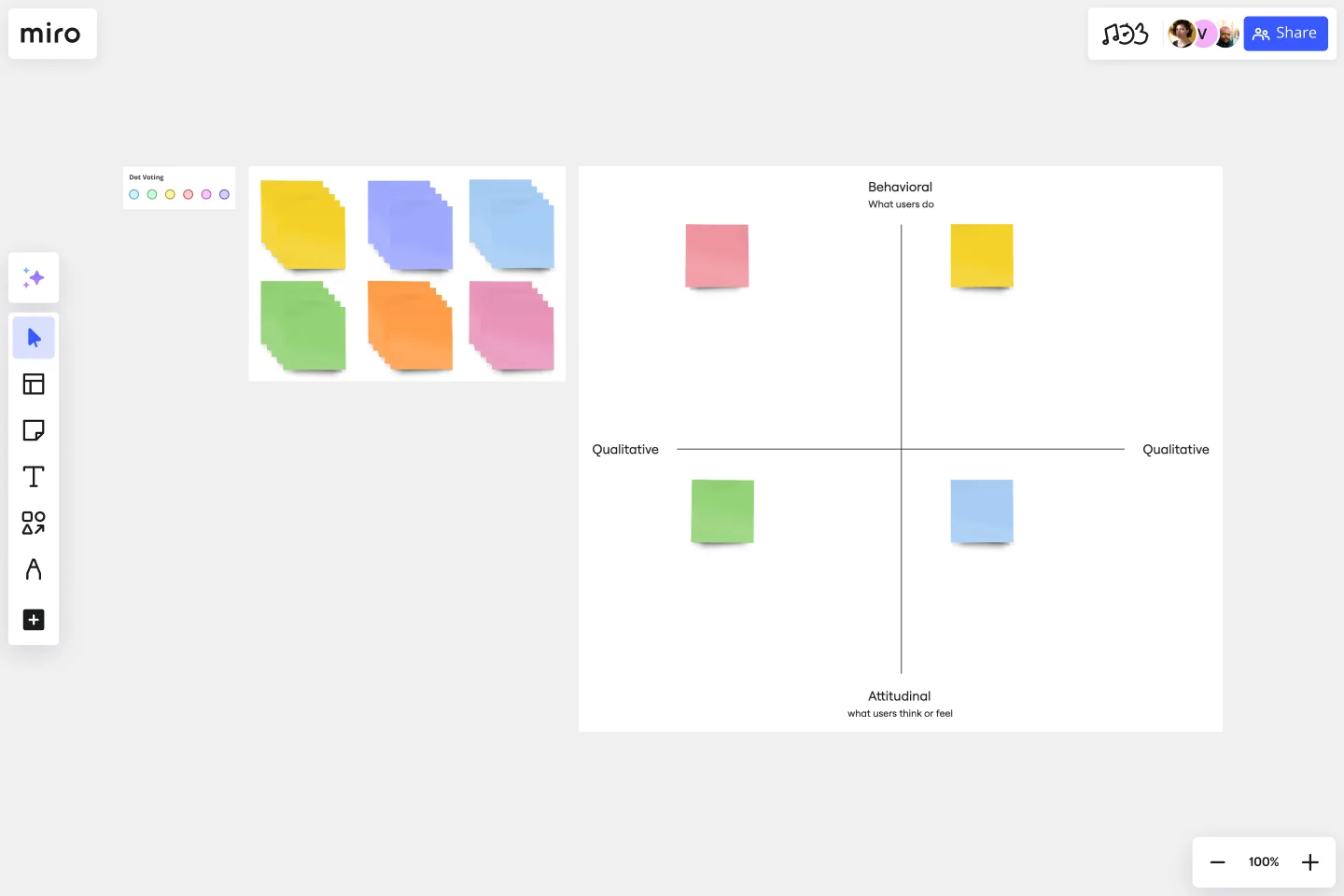
During the discovering the problem phase, the Design Research Template is your go-to tool. It helps you organize and document user insights, research findings, and key takeaways in one structured place. This template makes it easier to spot trends, synthesize your research, and ensure no important information gets overlooked.
Job map template
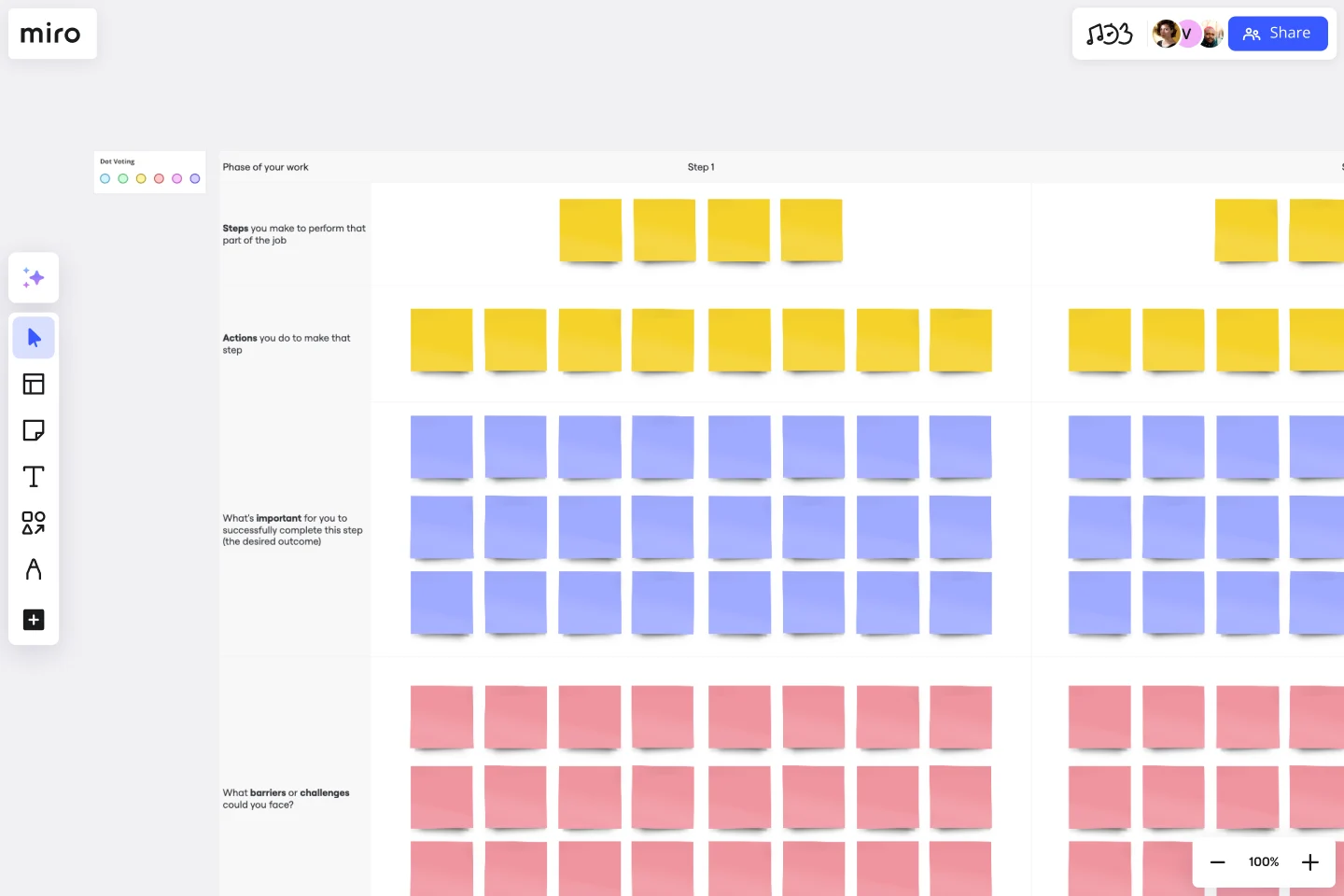
As you move into the defining the problem phase, the Job Map Template becomes invaluable. This template helps you map out how users approach tasks and where their pain points lie. By visualizing their journey, you'll better understand the specific problem you're solving and can define a problem statement that's focused and actionable.
Crazy eights template
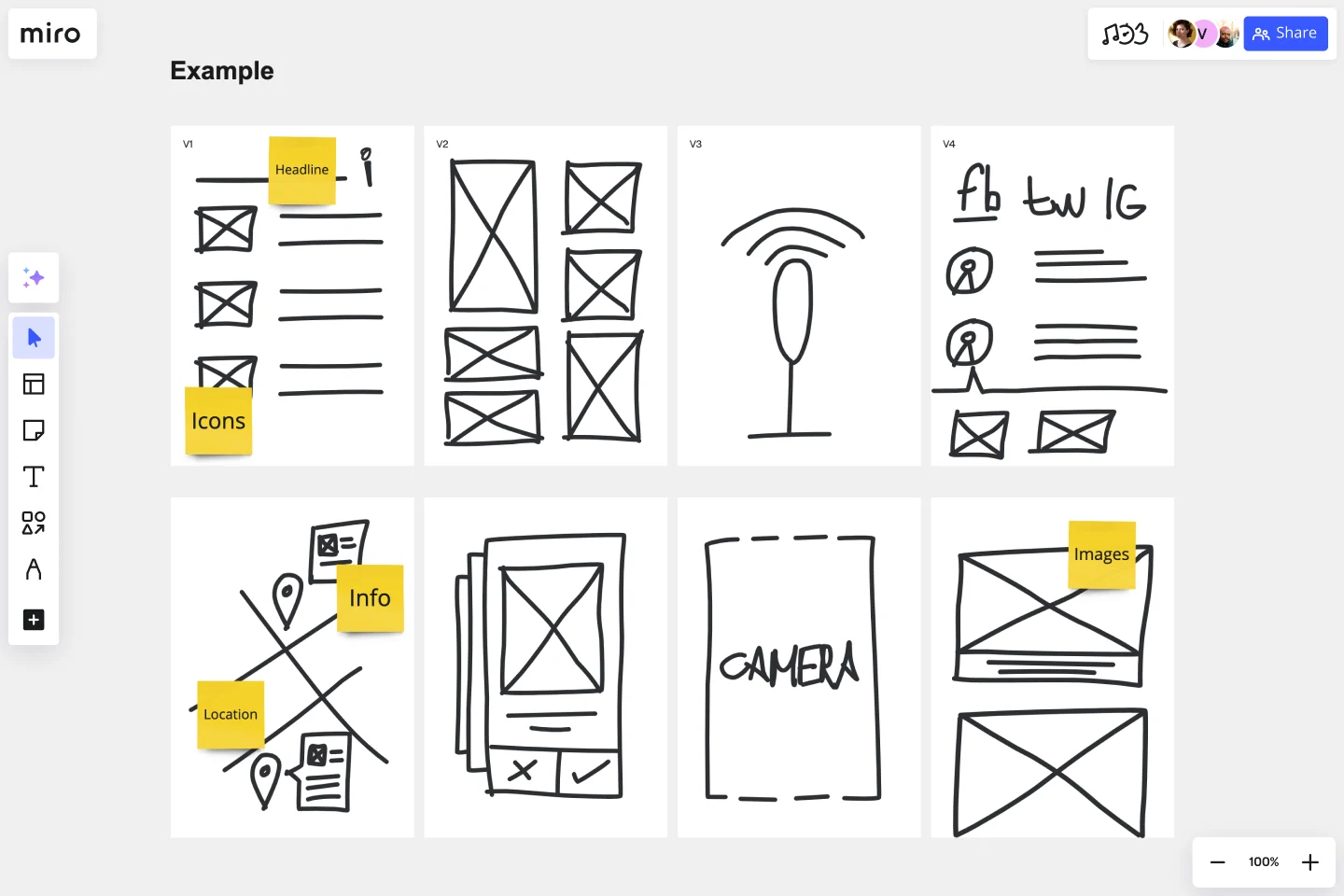
When it's time for ideation and brainstorming, the Crazy Eights Template is perfect for generating a wide variety of ideas quickly. This fast-paced ideation technique encourages out-of-the-box thinking and ensures that you explore many potential solutions before narrowing down to the most viable ones. It's an energizing way to get your team thinking creatively.
UX project canvas
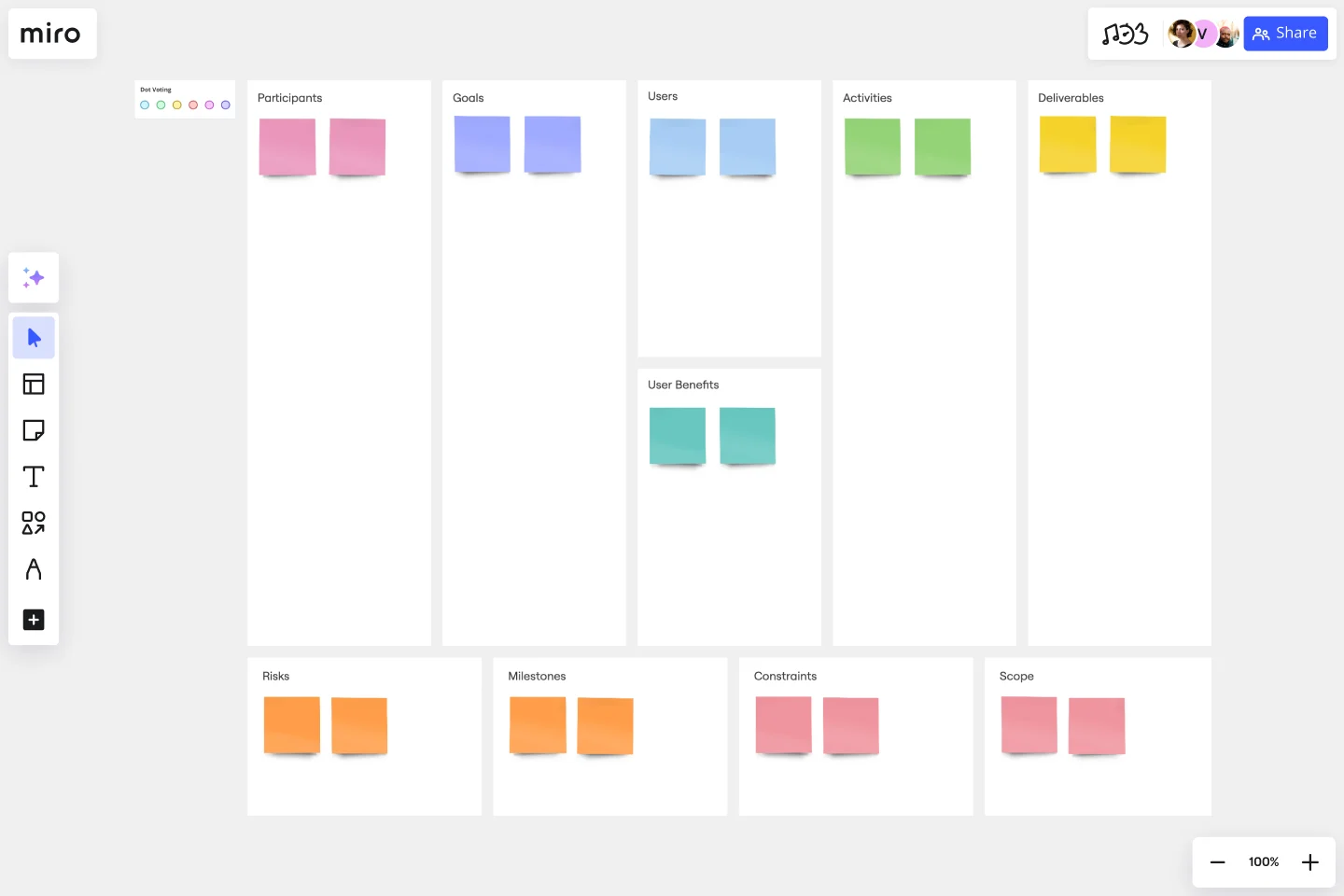
The UX Project Canvas can be particularly useful at both the ideation and early design stages. It helps you organize all the critical elements of your UX project—from user research to business goals—into one visual framework. This high-level overview ensures everyone on the team is aligned and that all project elements are considered before jumping into design.
Prototype template
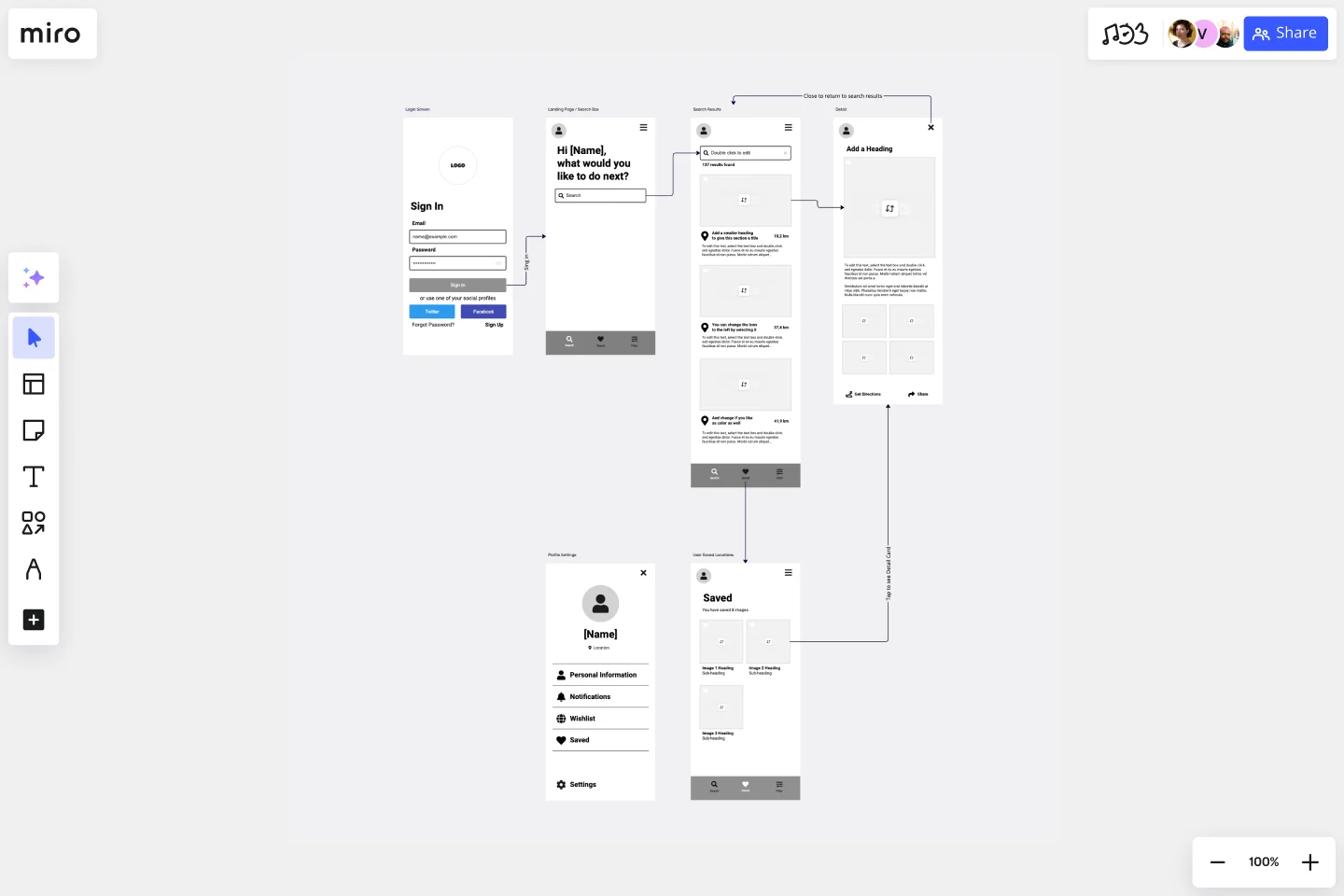
In the prototyping and testing phase, the Prototype Template helps you lay out early models of your product. Whether it's a low-fidelity wireframe or a clickable prototype, this template provides structure for testing key features with real users. It also helps you document feedback, so you can iterate quickly and refine your design.
Design critique template
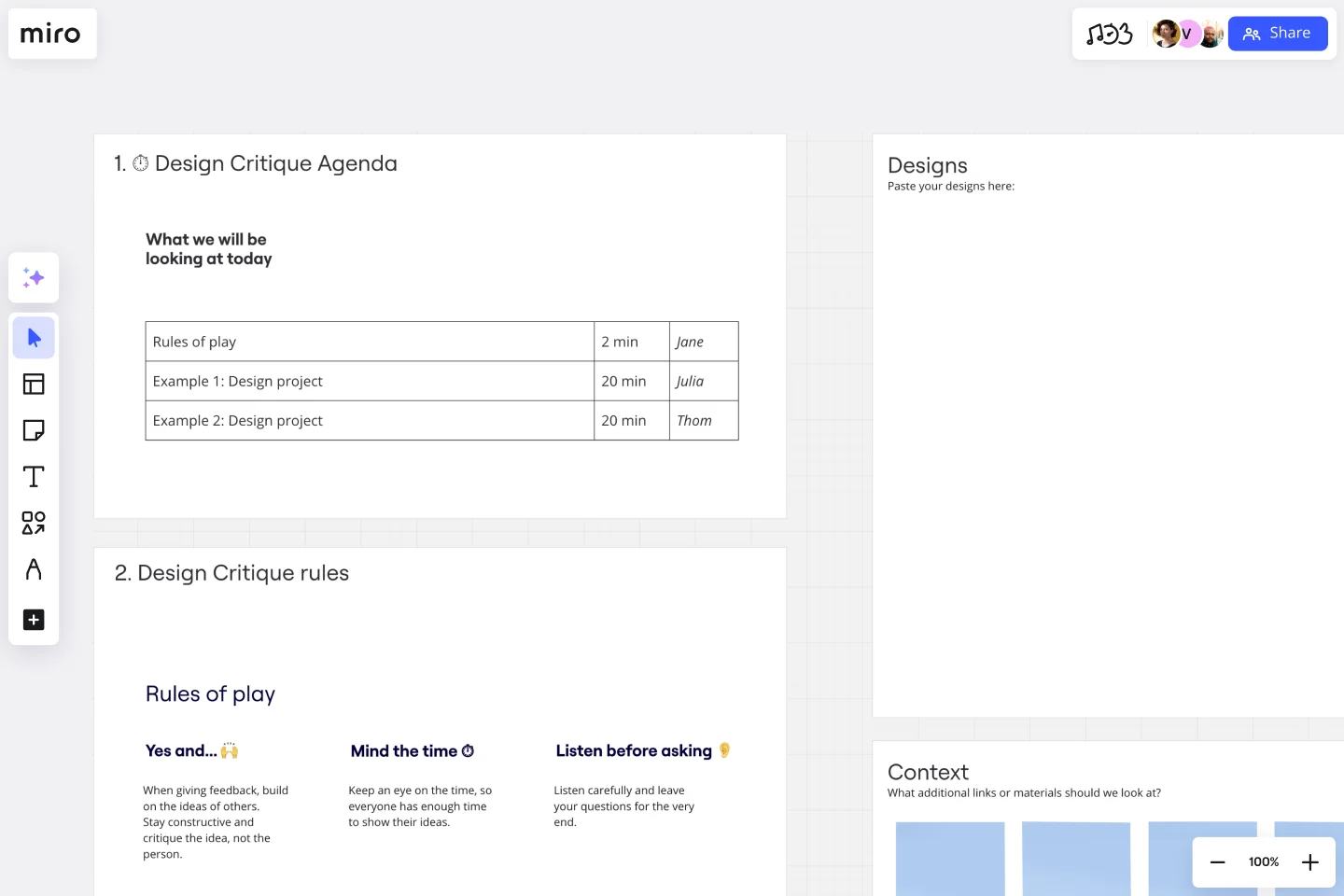
As you gather feedback on your prototype, the Design Critique Template helps structure that feedback into actionable insights. Whether you're running formal design reviews or informal critique sessions, this template ensures that feedback is constructive and focused on improving the design. It's an excellent tool for facilitating open discussions and making sure that every iteration brings you closer to a polished product.
Design sprint kit
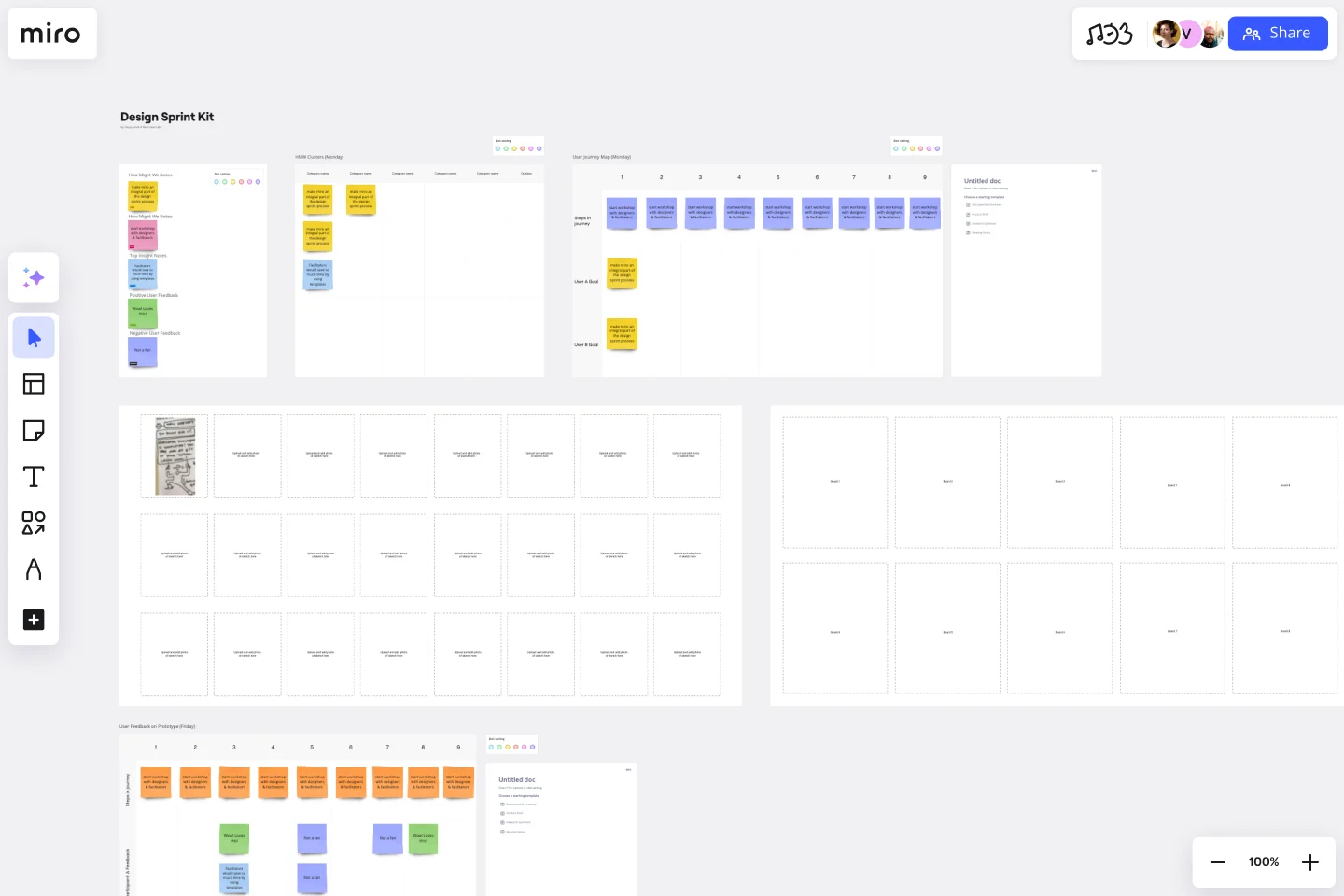
When you're in the iteration and refinement stage, the Design Sprint Kit is your best friend. This kit guides your team through focused design sprints, helping you quickly iterate, test ideas, and gather feedback. It provides a structured approach to problem-solving and ensures that each sprint ends with actionable results that move your product forward.
Design process flowchart
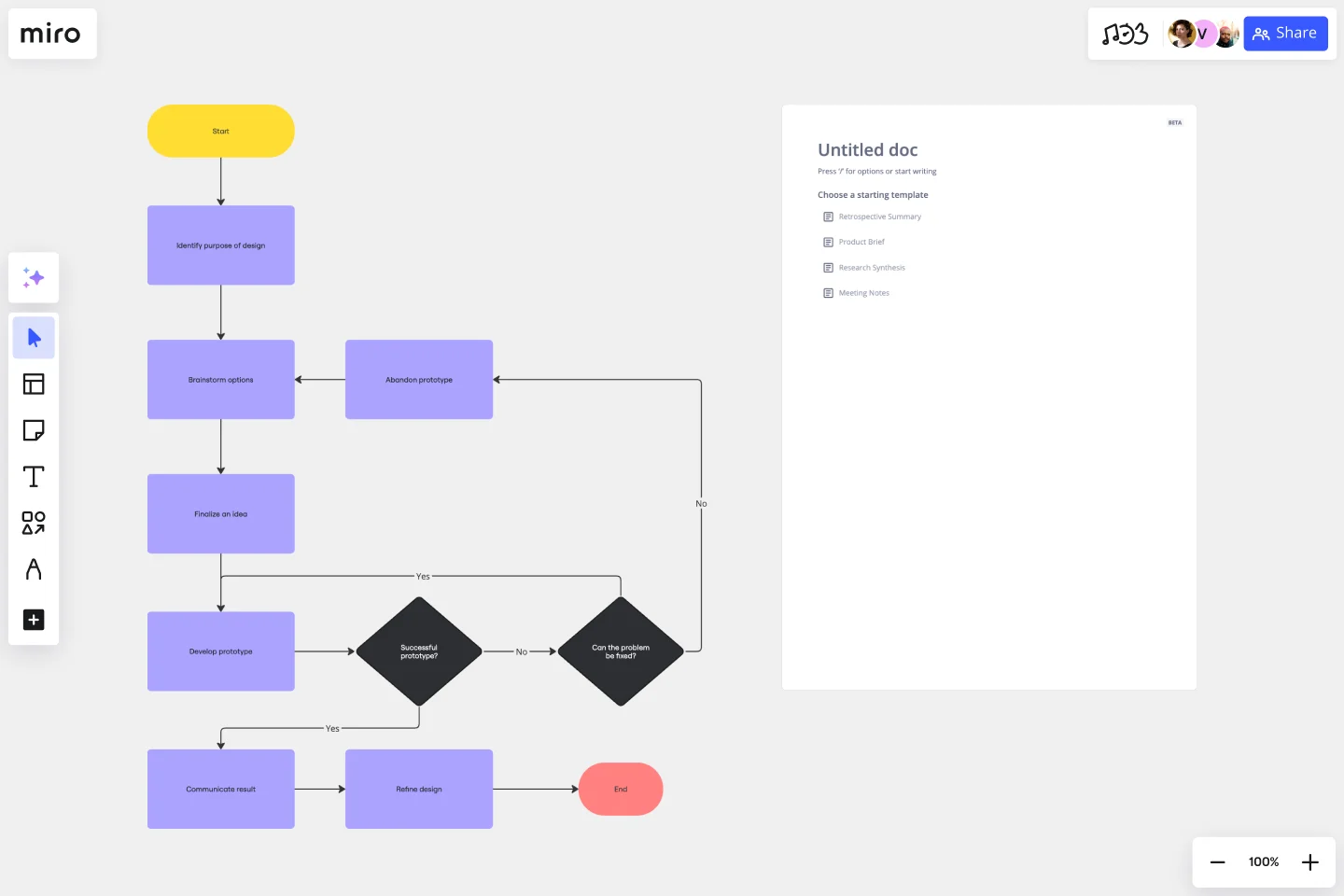
Finally, as you approach the finalization and launch phase, the Design Process Flowchart helps you visualize the entire design process. This template is particularly useful for tracking progress and ensuring that each team member understands their role in bringing the product to market. It's a great tool for maintaining alignment as you prepare for a successful launch.
Product design process and design thinking
You’ve probably heard the term “design thinking” before, and you might be wondering how it connects to the product design process. Design thinking is a human-centered, iterative approach to problem-solving that’s widely used in product design. It emphasizes empathy, creativity, and testing, making it a perfect match for the structured steps of the product design process.
What is design thinking?
Design thinking is a methodology focused on understanding the user’s needs and generating solutions through a series of iterative steps. It encourages teams to deeply empathize with the user, define the problem clearly, brainstorm solutions, prototype, and test those ideas quickly.
The core idea behind design thinking is to approach problems from the user’s perspective and to stay flexible and creative throughout the process, rather than jumping straight to building solutions.
How design thinking aligns with the product design process
While design thinking has five main stages (empathize, define, ideate, prototype, test), the product design process tends to follow a more structured seven-step approach. However, these two methodologies align closely in their focus on problem-solving, user feedback, and iteration. Let’s explore how they complement each other:
1. Discovering the problem (Product Design Process) and Empathize (Design Thinking): Both start by deeply understanding the user’s challenges and pain points. Through research methods like user interviews and surveys, teams can empathize with the end user and ensure they are solving a meaningful problem.
2. Defining the problem (Product Design Process) and Define (Design Thinking): After empathizing with users, both processes require teams to distill their findings into a clear, focused problem statement. This step is essential for aligning the team and guiding the rest of the design process.
3. Defining the solution (Product Design Process): This step doesn’t have a direct counterpart in design thinking, but it’s a critical part of the product design process. After defining the problem, the next step is to define a solution that directly addresses that problem. Teams must consider technical feasibility, user impact, and business goals when choosing the best solution to move forward.
4. Ideation and brainstorming (Product Design Process) and Ideate (Design Thinking): Once the problem and solution are defined, it’s time to brainstorm. Both processes encourage generating a wide range of ideas, pushing creative boundaries to explore all possible solutions. The goal is to think outside the box before narrowing down the best ideas.
5. Prototyping and testing (Product Design Process) and Prototype/Test (Design Thinking): Here’s where ideas come to life. In both approaches, teams build prototypes and test them with users to validate concepts. The goal is to gather real-world feedback and identify any usability or functionality issues before moving into full development.
6. Iteration and refinement (Product Design Process) and Test (Design Thinking): Both processes emphasize the importance of refining the product based on feedback. Iteration is critical to ensuring that the product meets user needs and is fully functional before launch. Teams repeat this cycle until the product is polished and ready for release.
7. Finalization and launch (Product Design Process): While design thinking doesn’t specifically include this step, it’s a crucial part of the product design process. Finalization involves aligning all teams—design, engineering, marketing—and preparing for a smooth product launch. Even after launch, gathering post-release feedback ensures continued improvement.
The power of design thinking in product design
Design thinking aligns closely with the product design process, adding a layer of creativity and empathy that enhances the overall outcome. While the product design process brings structure and rigor, design thinking emphasizes staying user-centered, embracing flexibility, and testing early. When combined, these two approaches ensure that your team builds products that not only work well but also meet real user needs.
Take your product design process to the next level with Miro
Product design is essential for the success of any product. Whether you’re building a new app, launching a service, or refining an existing product, the design process ensures that your solution aligns with both user needs and business goals.
From discovering the problem to launching your product, Miro is here to support your journey. Our innovation workspace enables teams to collaborate effectively, whether in real-time or asynchronously, from anywhere in the world. With templates that guide you through each step of the design process, Miro helps you stay organized, creative, and aligned as you bring your product to life.
If you’re ready to elevate your product design process, give Miro a try and see how we can help your team create better products faster.